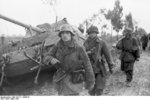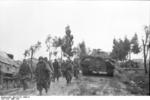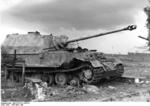Panzerjäger Tiger (P) 'Elefant'
| Country | Germany |
| Manufacturer | Porsche Aktiengesellschaft, Germany |
| Primary Role | Tank Destroyer |
Contributor: Alan Chanter
ww2dbaseDr. Ferdinand Porsche's design to the V.K.4501 specification which led to the mighty Tiger tank had some interesting and unusual features, such as petrol-electric drive and longitudinal torsion-bar suspension. So confident was the Porsche AG factory that their tank would be chosen for production that, on their own initiative, they built some ninety chassis of their own model; but when the rival Henschel design to the same specification was chosen these became immediately redundant. Nevertheless, five vehicles were completed at the Nibelungenwerke at Linz, German-occupied Austria as tanks (and used for trials only) and the remaining chassis were transported to the Alkett concern in Berlin, Germany to be modified into Panzerjägers (tank destroyers).
ww2dbaseThe resultant Panzerjäger, named at first Ferdinand (after Dr. Porsche) and later Elefant, involved the fitting of a fixed superstructure (armoured to a maximum of 200-mm) into which an 8.8-cm limited traverse PaK 43/2 anti-tank gun was mounted. In order to accommodate the gun, the layout of the vehicle had to be considerably altered. The driver's compartment became isolated from the rest of the vehicle and the engines were moved forward into what had originally been the turret space. The original engine intended by Porsche was replaced by two Maybach V-12 petrol engines, each 11,867 cc, developing 300 bhp at 3,000 rpm individually or 640 bhp combined. The Porsche Tiger's unique electric transmission unit (located beneath the fighting compartment) powered by a dynamo and driven by the twin engines however was retained in the Elefant tank destroyer.
ww2dbaseThe former engine space now became the fighting compartment, which had its front, sides and rear built up into a sloped walled box. In the front of this box went the 88-mm gun; hatches in the roof gave access to the fighting compartment, and a rear port allowed ejection of spent cartridge cases.
ww2dbaseAdolf Hitler demanded that the new vehicle, which weighed 67 tons and had a top speed was only 12½ mph, be ready for the 1943 offensive (much to the concern of his Inspector of Armoured Forces, General Guderian-who much preferred smaller, faster tank destroyers such as the Hetzer) on the Russian front, so the Elefant's development was somewhat hasty and consequently many Elefant tank destroyers in the two battalions so equipped (with 45 vehicles each) broke down in their first action at the Battle of Kursk in July 1943. Their lack of proper armour and ponderous mobility made them easy targets for Soviet gunners and the inexplicable oversight in not fitting a secondary armament (although a machine gun was belatedly incorporated later) meant that there was no defence against Soviet troops disabling the vehicle with explosive charges in close-quarter combat.
ww2dbaseThe survivors were withdrawn and used on other parts of the front and a few were sent to Italy, where their vulnerability, unreliability and lack of spares ensured their continued ineffectiveness. By the end of 1944 none remained in service.
ww2dbaseSources:
B. T. White, Tanks and other Armoured Fighting Vehicles 1942-45 (Blandford Press, 1975)
Philip Trewhitt, Armoured Fighting Vehicles (Dempsey-Parr, l999)
Ian V. Hogg & John Weeks, The Illustrated Encyclopedia of Military Vehicles (Hamlyn, 1980)
General Heinz Guderian, Panzer Leader (MacDonald-Futura, 1974)
Last Major Revision: Jan 2012
SPECIFICATIONS
Panzerjäger Tiger (P)
| Machinery | Two Maybach HL 120 TRM V-12 petrol engines rated at 300bhp each or 640bhp combined |
| Suspension | longitudinal torsion-bar |
| Armament | 1x8.8cm PaK 43/2 L/71 gun, optional 1x7.92mm MG34 machine gun |
| Armor | 30-200mm |
| Crew | 6 |
| Length | 8.13 m |
| Width | 3.38 m |
| Height | 3.00 m |
| Weight | 66.0 t |
| Speed | 13 km/h off-road; 30 km/h on-road |
| Range | 90 km off-road; 150 km on-road |
Photographs
 |  |  |  |
Please consider supporting us on Patreon. Even $1 per month will go a long way! Thank you. Please help us spread the word: Stay updated with WW2DB: |
- » US Government Plans to Purge WW2 Information (17 Mar 2025)
- » WW2DB's 20th Anniversary (29 Dec 2024)
- » Wreck of USS Edsall Found (14 Nov 2024)
- » See all news
 |
- » 1,167 biographies
- » 337 events
- » 44,601 timeline entries
- » 1,243 ships
- » 350 aircraft models
- » 207 vehicle models
- » 376 weapon models
- » 123 historical documents
- » 261 facilities
- » 470 book reviews
- » 28,511 photos
- » 367 maps
George Patton, 31 May 1944
Please consider supporting us on Patreon. Even $1 a month will go a long way. Thank you!
Or, please support us by purchasing some WW2DB merchandise at TeeSpring, Thank you!